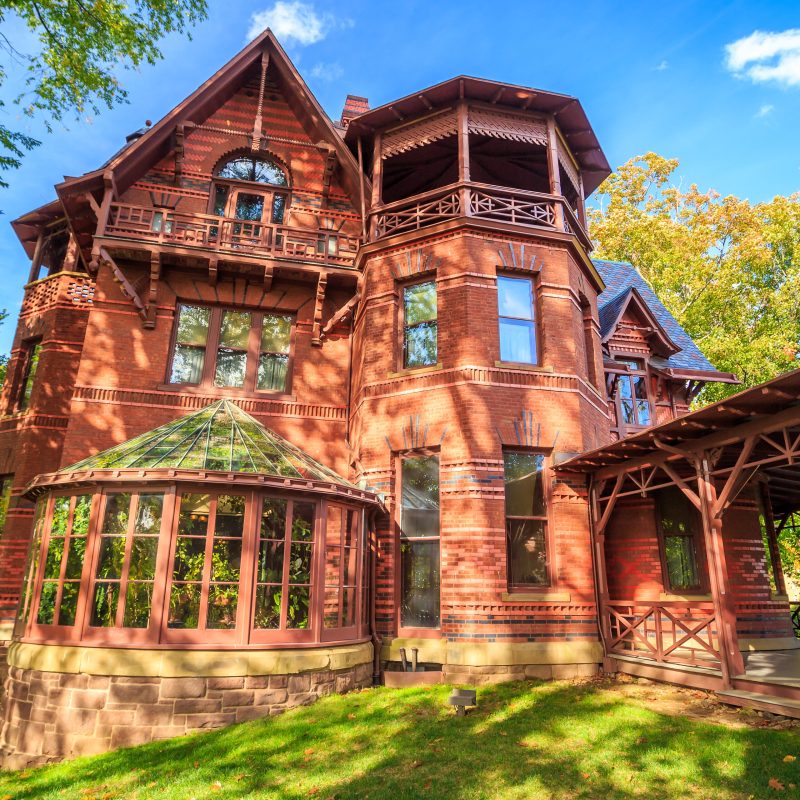
Have you ever wondered about the clapboard farmhouse that inspired Louisa May Alcott’s Little Women? Or the ocean air that stirred John Steinbeck’s Cannery Row? Or the “nothing but land” prairie landscape at the heart of Willa Cather’s My Ántonia?
Videos by TravelAwaits
No need to ponder any longer, because the homes of all three American authors are preserved and open to visitors in Concord, Massachusetts; Salinas, California; and Red Cloud, Nebraska, respectively.
And these represent just a small sample of the author-centered museums available all over the country.
Whether your interests center on 19th-century poets, 20th-century novelists, or humorists for the ages, you will find towns and cities that celebrate their famous literary sons and daughters.
Here are 10 places where you can breathe the air, walk the hallways, and take in the views that inspired some of your favorite American authors.
Amherst, Massachusetts — Emily Dickinson
Although nearly 150 years have passed since her death in 1886 at the age of 55, Emily Dickinson never seems to go out of vogue.
In fact, the reclusive American poet is currently having a pop-culture moment with the new Apple TV+ comedy-drama Dickinson, starring Hailee Steinfeld as the young Emily.
Fans of Dickinson’s work can get a taste of what her life was really like at the Emily Dickinson Museum in Amherst, Massachusetts. There, two Dickinson family homes are preserved: The Homestead, the birthplace and home of Dickinson, and The Evergreens, the next-door home of her brother and sister-in-law, Austin and Susan Dickinson.
“The museum is dedicated to sparking the imagination by amplifying Emily Dickinson’s revolutionary poetic voice from the place she called home,” says the museum’s website.

Cindy Barks
Salinas, California — John Steinbeck
California’s varied terrain — from the blue waters of the Pacific Ocean to the rolling hills of the Salinas Valley — was a recurring theme in Pulitzer- and Nobel-Prize-winning author John Steinbeck’s works.
“The Pacific is my home ocean; I knew it first, grew up on its shore, collected marine animals along the coast. I know its moods, its color, its nature,” Steinbeck wrote in Travels with Charley.
So, it is appropriate that Steinbeck’s birthplace of Salinas, California, just 10 miles inland from the Pacific Coast, serves as the location for the author’s museum.
The midsize city is home to both the informative and interactive National Steinbeck Center and the Steinbeck House Restaurant, located in Steinbeck’s restored Victorian boyhood home.

Cindy Barks
Payson, Arizona — Zane Grey
Few authors sum up the adventurous American West as does early 1900s novelist Zane Grey, known for Riders of the Purple Sage and The Call of the Canyon.
The inspiration for many of his novels can be traced to the high-country forestland of Northern Arizona where he had a cabin, which is now open to visitors as the Zane Grey Cabin Museum on the grounds of the Rim Country Museum in Payson, Arizona. (The original 1920s-era Zane Grey cabin burned in the devastating Dude Fire of 1990, but the cabin was recreated several years ago on the museum grounds.)
Museums memorializing Grey also exist in Ohio and Pennsylvania, where the author grew to adulthood. But the Arizona high country loomed largest in his work. Of the 57 novels Grey penned, 28 of them had an Arizona theme.
Portland, Maine — Henry Wadsworth Longfellow
Walk along the narrow and slightly damp hallways of Henry Wadsworth Longfellow’s boyhood home in Portland, Maine, and you will instantly gain insight into his poem The Rainy Day, which famously reminds readers, “Into each life some rain must fall, / Some days must be dark and dreary.”
The 19th-century author and poet hailed from Portland, and his family home now serves as the Wadsworth-Longfellow House & Garden, a museum operated by the Maine Historical Society.
The historic brick house lies in the midst of the bustling city and serves as a reminder of the nation’s early years, when Longfellow’s grandfather, General Peleg Wadsworth, built the family home in 1785.

Concord, Massachusetts — Louisa May Alcott
Generations of readers have immersed themselves in the 1868 classic Little Women, which explores the lives of the four March sisters growing up in New England during the American Civil War.
The story is so enduring that at least eight movie adaptations have been made, including the latest, which was released in late 2019.
A real-life look at the family that inspired the March sisters is available at author Louisa May Alcott’s Orchard House in Concord, Massachusetts.
The 1660s-era farmhouse was the home of Alcott’s family from 1857 to 1877 and is said to be the setting for Alcott’s classic story.

Hartford, Connecticut — Mark Twain
When it comes to American classics, Mark Twain’s The Adventures of Tom Sawyer and The Adventures of Huckleberry Finn consistently rank among the best.
The Mark Twain House & Museum in Hartford, Connecticut, is a classic of its own. Billed by Twain as “a house with a heart and soul,” the American High Gothic-style mansion on Hartford’s Farmington Avenue served as the home of Twain (author Samuel Clemens) and his family for nearly 20 years in the late 1800s.
Along with the restored house, the center also includes a museum, which opened in 2003.

Key West, Florida — Ernest Hemingway
Pulitzer- and Nobel-Prize-winning author Ernest Hemingway’s penchant for living large is on display throughout the Ernest Hemingway Home and Museum in Key West, Florida.
From the massive 60-foot-long swimming pool that is said to have cost $20,000 in 1937 (more than $350,000 in today’s dollars) to the six-toed cats that still roam the property, the Florida home sums up the bold and adventurous author of such masterpieces as The Sun Also Rises, A Farewell to Arms, The Old Man and the Sea, and The Moveable Feast.
Red Cloud, Nebraska — Willa Cather
The United States prairie was the specialty of Pulitzer-Prize-winning author Willa Cather, and she brought the flat, empty terrain to life in works such as My Ántonia and O Pioneers!
“There was nothing but land; not a country at all but the material out of which countries are made,” Cather wrote in My Ántonia of the fictional Black Hawk, Nebraska.
Today, the National Willa Cather Center stands in the author’s honor in her hometown of Red Cloud, Nebraska, which inspired Black Hawk.

Glen Ellen, California — Jack London
Extreme endeavors were the hallmark of Jack London, and the Jack London State Historic Park in Glen Ellen, California, pays tribute to that spirit, along with the works of the famous early 1900s author and social activist.
Known for shocking tales of the Klondike Gold Rush in his novels The Call of the Wild and White Fang, as well as in the short story To Build a Fire, the San Francisco-born London called a ranch on the eastern slope of Sonoma Mountain home for the last decade or so of his life.
The ranchland, which includes the remains of London’s Wolf House mansion, today features a visitor center in the House of Happy Walls that was built by London’s widow, fellow author Charmian Kittredge London. The ranch became a California Historical Landmark and State Park in 1960.

Walnut Grove, Minnesota; De Smet, South Dakota; Mansfield, Missouri — Laura Ingalls Wilder
Anyone who remembers hearing bedtime stories that featured tales of little Laura navigating the frontier with her family would probably enjoy visiting several museums that honor author Laura Ingalls Wilder.
Famous for wholesome stories like Little House in the Big Woods and Little House on the Prairie, Wilder has been a mainstay for generations of young readers. Her stories were transformed into the popular Little House on the Prairie TV series in the 1970s and 1980s.
The museums include Wilder’s childhood home in Walnut Grove, Minnesota; the Laura Ingalls Wilder Historic Homes and first school of Laura and her sister Carrie in De Smet, South Dakota; and the Laura Ingalls Wilder Historic Home & Museum at Rocky Ridge Farm in Mansfield, Missouri, where Wilder is said to have penned her books.
